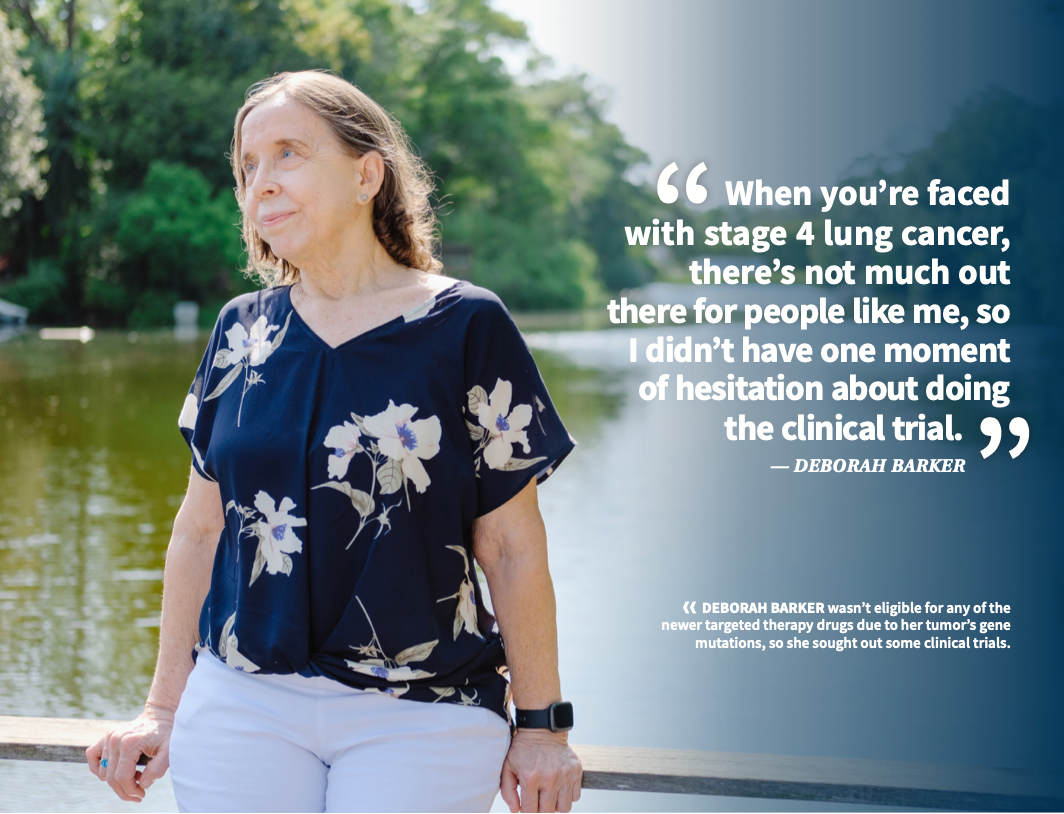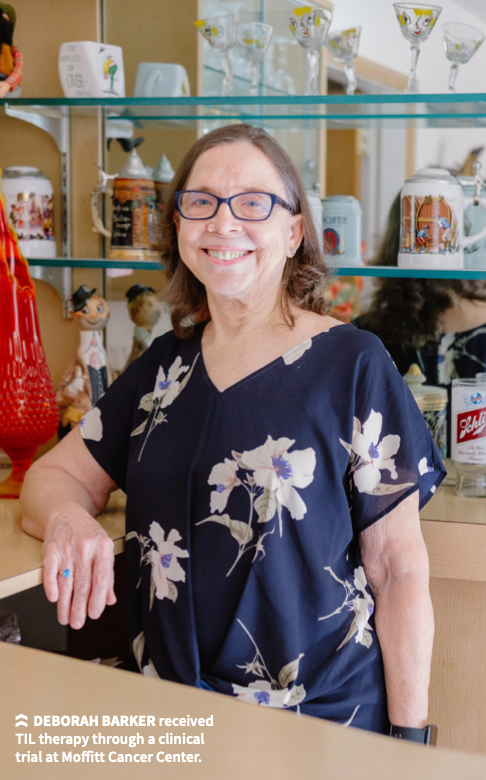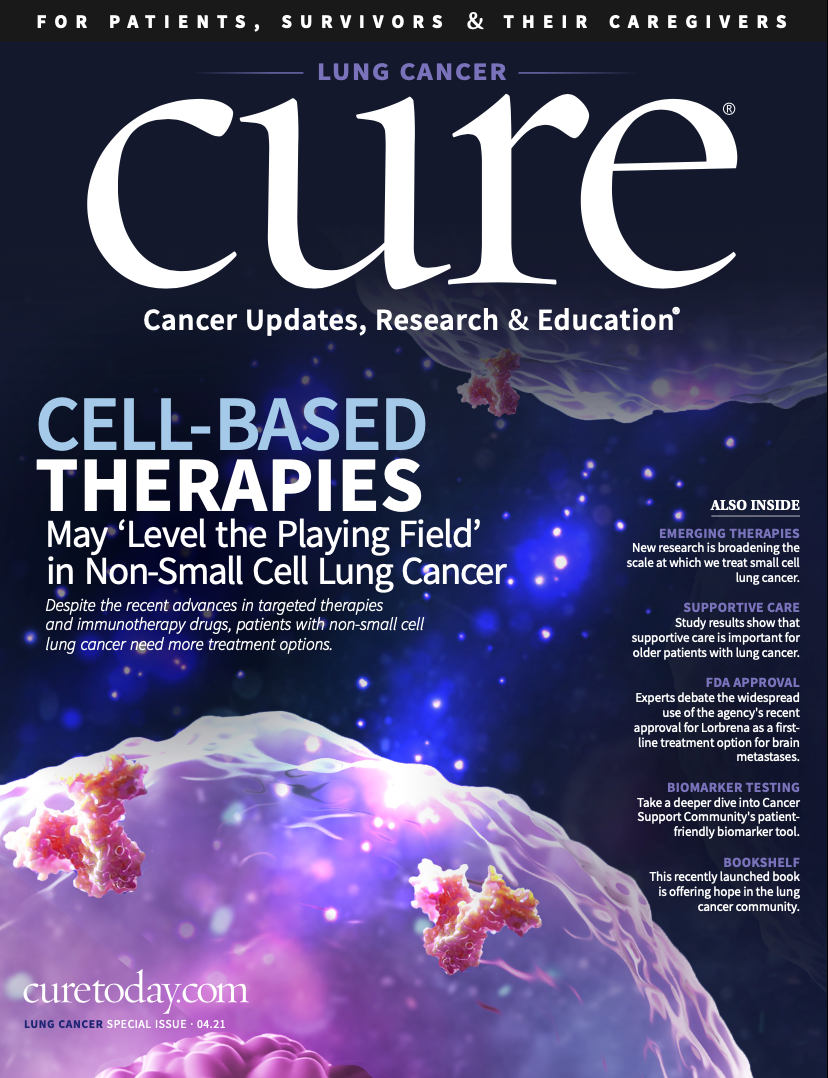Publication
Article
Cell-Based Therapies May ‘Level the Playing Field’ in Non-Small Cell Lung Cancer
Author(s):
Even with all the recent advances in targeted therapies and immunotherapy drugs, patients with non-small cell lung cancer still need more treatment options. Although it’s early, cell-based therapies have shown some promise, with more research underway.
In the fall of 2017, Deborah Barker noticed a strange pain developing on the left side of her body, around waist level. An avid scuba diver and underwater photographer, she thought it might be related to a back injury and requested an MRI from her primary care doctor.
The scan identified a lesion close to her spine, which was concerning. But she was floored after her biopsy when the pathology results came back with a diagnosis of stage 4 non-small cell lung cancer (NSCLC).
“It was really shocking. You think, ‘Oh, God, this is it.’ And my dad died of lung cancer in 2000,” says Barker, 69, who lives in St. Petersburg, Florida. “I went through the normal, scary feelings for about a week, and then I remember being real anxious to start treatment.”
Her local oncologist recommended radiation therapy right off the bat since the lesion was so close to the spine. But her tumor didn’t have any of the gene mutations that would make her eligible for the newer targeted therapy drugs. Barker wasn’t satisfied with receiving only the standard treatment regimen of chemotherapy and asked him about clinical trials for metastatic lung cancer.
“I had gone through a clinical trial with my sister back in 2007. She had severe aplastic anemia and I was the donor for her stem cell transplant,” she says. “That went real well for her, and it was kind of neat going through it all.”
After being disqualified for a study based in her hometown because the researchers were unable to get a large enough biopsy sample, Barker headed to the much larger Moffitt Cancer Center in neighboring Tampa. There, she learned about a clinical trial for tumor-infiltrating lymphocyte (TIL) therapy, a type of cellular immunotherapy being newly tested in patients with NSCLC. It extracts immune cells present inside and presumably attacking the tumor, grows billions of them in a lab and then infuses them back into the patient.
Such approaches to immunotherapy, which involve modifying the patient’s own immune cells to more successfully attack the cancer cells, were first used to treat melanoma or blood cancers such as lymphoma and leukemia. Recently, clinical trials have explored the efficacy of TIL therapy and another type called chimeric antigen receptor (CAR)-T cell therapy in other cancer types, including lung cancer. Early results appear promising and give hope to patients with metastatic disease, like Barker, who lack options.
“We have a long track record of a percentage of patients with metastatic melanoma getting durable, complete responses from TIL therapy dating back to the 1980s,” says Dr. Ben Creelan, medical oncologist and principal investigator of the TIL therapy clinical trial at Moffitt. “Based on that positive experience, we wanted to take that into lung cancer and see if we could achieve similar results. Of the lung cancer patients we treated, a proportion of them have had durable responses lasting four years now, in some cases.”
Breaking Down Cell-Based Therapies
Cell-based therapy encompasses a broad range of techniques that all include the injection or transplantation of cellular material into a patient. For example, bone marrow trans- plants infuse healthy, blood-forming stem cells into the body to replace damaged or diseased bone marrow. They could be cells from a donor or the patient’s own cells.
Cellular immunotherapy — which includes TIL therapy, CAR-T cell therapy and others —specifically focuses on immune cells. TIL therapy extracts a patient’s own TILs or immune cells that have moved from the blood into a tumor and stimulates their growth in tissue culture. CAR-T cell therapy, on the other hand, collects a type of white blood cell, called T cells, from a patient and genetically alters them to better identify cancer cells.
Both therapies then inject the modified immune cells back into the patient so they can go to work, newly empowered to attack the cancer cells. Patients usually need to receive chemotherapy before the infusion to wipe their immune system clean of other immune cells.
“The main side effects of cell-based therapies are due to this conditioning chemotherapy that can be a little bit rough,” explains Dr. Erminia Massarelli, co-director of the lung cancer and thoracic oncology program and an associate clinical professor of medical oncology and therapeutics research at City of Hope in Duarte, California. “So the patient will need to be at a good stage of their well-being — we call it ‘performance status’ — to tolerate this type of chemo- therapy. We cannot treat patients who are in a wheelchair, for example, or oxygen dependent.”
Massarelli and her colleagues are currently recruiting participants for a phase 2 clinical trial investigating TIL therapy for patients with metastatic NSCLC. They are part of a recent wave of researchers hoping to transfer the success of cellular immunotherapy in hematological malignancies to lung cancer. At this point, the Food and Drug Administration has approved four types of cellular immunotherapy — all CAR-T cell therapies — for patients with different kinds of blood cancers.
These strategies have had limited efficacy in patients with solid tumors, mainly because solid tumor cells lack an easy target for immune cells to latch onto. Normally, T cells use receptors to attach to proteins called antigens on the surface of invading cells. This lock-and-key mechanism allows T cells to recognize and destroy the invading cells. CAR-T cell therapy adds a man-made receptor — the chimeric antigen receptor, or CAR — specific to a cancer-specific antigen to the patient’s harvested T cells.
However, there isn’t a widely expressed antigen in solid tumors that doesn’t also appear on normal cells. So the infusion of modified cells might kill a patient’s cancer cells but end up hurting healthy tissue in the process. In addition, solid tumors and their antigens mutate so frequently that using traditional CAR-T cell therapy on them becomes like shooting a moving target.
“The problem with lung cancer is that the cancer cells are constantly evolving, and they’re all very different. It’s very challenging to pick a specific target,” says Dr. Adam Schoenfeld, a medical oncologist at Memorial Sloan Kettering Cancer Center in New York City. “Our therapies continue to evolve with new techniques, but we still face the challenge of a multitude of targets and potential resistance.”
In this sense, TIL therapy has the advantage for treating lung cancer since the immune cells infiltrating a tumor are already trained against a patient’s specific tumor antigens. The lymphocytes, after being extracted from the patient, go through testing in the lab to determine which ones best recognize the tumor cells. The front-runners are then chosen and allowed to multiply before going back into the patient.
Encouraging Early Results
TIL therapy remains in early stages for solid tumors other than melanoma, although recent studies have reported some success in head and neck cancer and cervical cancer. Last year, Moffitt’s phase 1 clinical trial in lung cancer demonstrated the safety and efficacy of TIL therapy for this patient population. Creelan and his colleagues recruited 20 patients with metastatic NSCLC, including Barker, and two have achieved complete responses with no evidence of disease on their scans.
“Stage 4 lung cancer traditionally has a lot of room to go when it comes to getting durable remission for patients,” Creelan notes. “I would say that a good number of the patients we treated were never smokers and historically bereft of immunotherapy options, and now it seems like (TIL therapy) could level the playing field.”

Overall, the clinical trial went smoothly for Barker, although things didn’t happen exactly as planned. To collect the lymphocytes, a surgeon removed part of the tumor from her right upper lung with minimally invasive robotic surgery. While waiting for the immune cells to multiply in the lab, she received an immunotherapy drug called Opdivo (nivolumab) for about a month. To everyone’s surprise, she fared very well on Opdivo — so much so that she didn’t require TIL therapy after all.
“I was getting a good response, and then I was told, ‘Well, we’re not going to give you your cells,’” says Barker. “That was really interesting because I had a combination of being happy that I was responding but disappointed that I wasn’t getting my cells.”
Barker ended up receiving her cells almost a year later, when an imaging scan spotted a recurrence. Thankfully, Moffitt had frozen her billions of lymphocytes, and Creelan assured her they were still viable. She went through a grueling week of chemotherapy to flush her immune system clean, which left her fatigued and bedridden, and then received the infusion of cells over several hours.
Although the cell infusion itself doesn’t have any notable side effects, other aspects of TIL therapy can take a toll on patients. Because of low blood cell counts, Barker needed blood transfusions after chemotherapy, and most patients in the study experienced low levels of albumin, phosphate and sodium in the blood. Other reported side effects included nausea and diarrhea. However, most of these side effects resolved after roughly 10 days.
In addition, all patients were put on interleukin 2, an immunotherapy drug that increases the growth and activity of T cells, for five days after infusion. Common side effects related to interleukin 2 use include fever, chills and other flu-like symptoms.
Although the initial results of this phase 1 trial seem promising, a much clearer picture should emerge within the next few years regarding the role of cell-based therapies in treating lung cancer. Investigators with phase 2 clinical trials by Massarelli, Schoenfeld and other research groups hope to publish their results by 2024 or earlier.
“I’m very curious to see the results of our current efforts with TIL-based therapies. I think the early data are encouraging, so this could be a potential option in the next few years if we have results similar to what we’re seeing in melanoma translate over to lung cancer,” Schoenfeld says. “One of the things we’re exploring with these studies is looking at them in earlier settings and if that is potentially helpful.”
Working in Combination
Experts believe cellular immunotherapy could be more effective if given to patients before their immune system becomes suppressed by chemotherapy and other forms of treatment. About half of the participants in Creelan’s study, for instance, had not received any prior treatment.
“I wouldn’t say that it’s something that you would reserve for the very last line, because usually patients aren’t healthy enough to go through with it if they’ve been through five or six different previous treatments,” says Creelan. “Reserving a trial for the very end rarely works, because usually by that point, patients are too sick to be eligible for these kinds of studies.”
Researchers are also exploring whether cell-based therapies could work better in combination with immunotherapy drugs like Keytruda (pembrolizumab). Early data suggest that pairing the two types of treatment may help reduce drug resistance and increase long-term response. Other studies focus on tweaking aspects of CAR-T cell therapy to make it more suitable for lung cancer, by evaluating new antigen targets that won’t harm as much healthy tissue. And still others are testing less-established cellular immunotherapies for lung cancer like T-cell-receptor-engineered cells, double-negative T cells and clonal neoantigen T cells.
Regardless of the approach, one thing remains clear: Patients with NSCLC still need more treatment options, even with all the recent advances in targeted therapy and immunotherapy drugs. Not everyone responds to immune checkpoint inhibitors such as Opdivo and Keytruda or is eligible for targeted therapy drugs.
“The majority of non-small cell lung cancer patients actually don’t have targetable mutations — I would say about 60% to 70% of non-small cell lung cancer patients don’t have specific targets — so they are mainly treated with chemotherapy and immunotherapy,” Massarelli says. “So cell-based therapies are very good options for these kinds of patients.”

After receiving TIL therapy through the clinical trial at Moffitt, Barker has been in remission since June and celebrated her three-year survival in October. She looks forward to getting back into the water with her scuba gear as soon as the weather warms up.
Although she normally travels to exotic destinations like the Galapagos Islands, the Philippines and Indonesia for her dives, the COVID-19 pandemic has thrown a wrench into Barker’s international travel plans. But there are plenty of local options in her home state of Florida, and she feels an overwhelming sense of gratitude to have her life and health back.
“My quality of life has been great, and I feel completely blessed,” Barker notes. “When you’re faced with stage 4 lung cancer, there’s not much out there for people like me, so I didn’t have one moment of hesitation about doing the clinical trial.”
For more news on cancer updates, research and education, don’t forget to subscribe to CURE®’s newsletters here.




